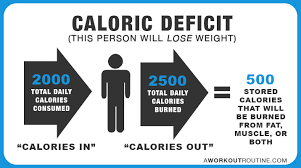If you want to measure and maintain a calorie deficit, then you need to first calculate how many calories your body burns in a given day. This means looking at the number of calories that you burn while inactive (called your ‘basal metabolic rate’) and then looking at how much exercise you do on top of this – making your AMR or ‘active metabolic rate’. There are plenty of different calculations out there for getting a rough estimate of these numbers.
Ultimately though, it is actually more effective in most cases to try and work this out using a fitness tracker. While calculations can be useful, they don’t allow for variations from one day to the next. Most of us will find that our active metabolic rate varies tremendously throughout the week and this of course has a big impact on how much you should be eating.
A good fitness tracker will allow you to enter some personal metrics, such as your height, weight and gender, and will then count your steps and measure other activities throughout the day. A device such as the Fibit Alta HR for instance will not only track steps but also monitor your heartrate throughout the day and automatically detect exercises and activities like walks, runs and sports. Using this data, you can then get a much more accurate picture of how many calories you burn daily.
From there, you can then start calculating how many calories are going in. Again, there is technology out there to help you do this. MyFitnessPal for example is a tool that will let you log the foods you eat by entering the calories and ‘macronutrients’ manually, or by simply scanning a barcode in order to add them from a huge database.
If you scan everything you eat through MyFitnessPal – not forgetting the drinks you consume (including alcoholic!) and any smaller snacks throughout the day – then you now have a total number for all the calories you’ve eaten to measure against the ones you’ve burned.
Now all you need to do is to plan your day so that the number of calories coming in stays lower than those going out. Let’s say that you’ve burned 2,300 calories and you’ve eaten 2,200.
You can either stop there, or you can try and do some more exercise in order to burn more calories. Either way, you need to keep the first number higher than the second one. If you can do that, then you will burn fat. It’s that simple and it has to work – because there’s no other source of energy for your body to get fuel from.
Maintain a constant caloric deficit of around 200-300 and you’ll slowly lose more and more fat. Remember: slow and steady wins the race!
Except it’s not really that simple. Is it? For starters, there are the kinds of foods you’re eating – the nutrients. Then there is the matter of your metabolism and, you know, life. Maintaining a caloric deficit seems simple and flawless on paper but in practice, it is too simplistic. Over the next few chapters you’ll discover why and you’ll find out how to strike that happy balance that will result in guaranteed fat loss.
Discover more from Personal Blog of Richard Tong
Subscribe to get the latest posts sent to your email.





Wonderful write-up! You’ve made some excellent observations.
Will share this with others
Great article. Your perspective is refreshing. Looking
forward to more
Interesting post… Your perspective is refreshing.
Will share this with others
Excellent content! I completely agree with your points. Keep up the good work
That is a great tip especially to those fresh to the blogosphere. Simple but very accurate information횜 Many thanks for sharing this one. A must read post!
I wanted to thank you for this wonderful read!! I absolutely enjoyed every little bit of it. I’ve got you bookmarked to look at new things you postÖ
I must thank you for the efforts you have put in penning this blog. I’m hoping to view the same high-grade blog posts from you later on as well. In fact, your creative writing abilities has encouraged me to get my own, personal blog now 😉
to do my breakfast, after having my breakfast coming {againyet
I blog quite often and I really thank you for your content.This great article has really peaked my interest.I will book mark your blog and keep checking for new information aboutonce per week. I subscribed to your RSS feed as well.
This is my first time go to see at here and i am in fact impressed to read everthing at one place.
I appreciate you sharing this blog post.Thanks Again. Cool.
Hey, thanks for the blog article.Really thank you!
Fantastic article.Really looking forward to read more.
This is one awesome article post.Really looking forward to read more.
Really informative article.Really looking forward to read more. Great.
Very neat blog post.Really thank you! Really Cool.
Fantastic blog article.Really looking forward to read more. Really Great.
infinitivo ¿Tengo el infarto de viruela en mi brazo?
infinitive Do I have a smallpox heart attack on my arm?